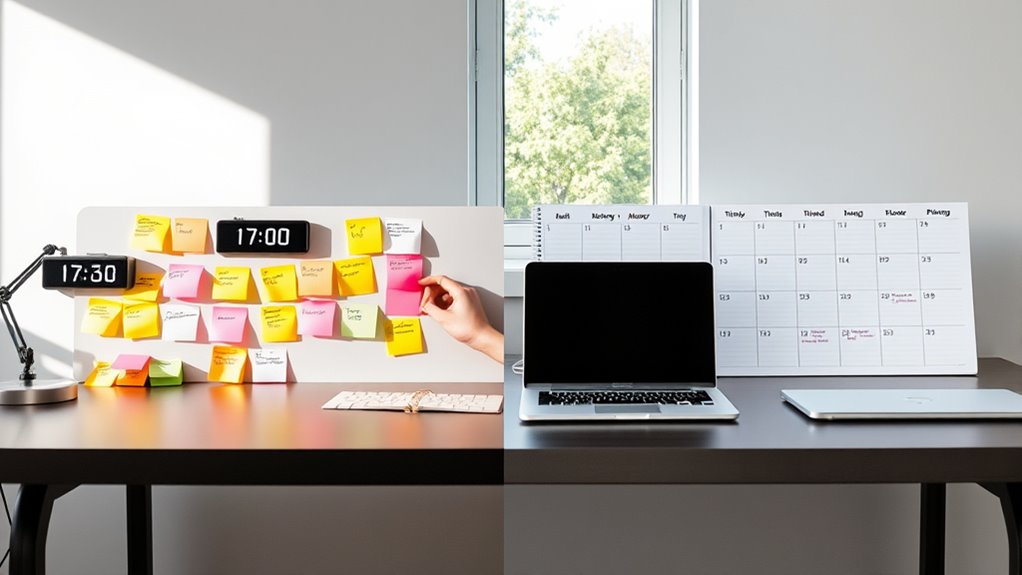If you’re trying to decide between timeboxing and time blocking, consider your focus and planning style. Timeboxing sets a fixed period for specific tasks, helping you prioritize and complete them within a set timeframe. Time blocking divides your day into larger segments for broader categories, offering a structured, big-picture approach. Understanding which method aligns with your work habits can boost your productivity; keep exploring to see which fits your day best.
Key Takeaways
- Timeboxing assigns fixed time limits to specific tasks, promoting focus and timely completion, while time blocking schedules broader periods for categories of activities.
- Timeboxing emphasizes prioritization within strict time constraints, preventing tasks from dragging on, whereas time blocking provides a structured overview of daily commitments.
- Timeboxing minimizes distractions by creating dedicated, limited work sessions, while time blocking organizes the day into larger segments for overall task management.
- Timeboxing is ideal for tasks requiring intense focus and urgent deadlines, whereas time blocking suits planning multiple related activities across the day.
- Choosing between them depends on your need for detailed time management (timeboxing) versus overall daily structure (time blocking).

When it comes to managing your time effectively, understanding the difference between timeboxing and time blocking can make a significant impact. Both techniques aim to structure your day, but they do so in distinct ways that influence how you handle task prioritization and distraction management. Timeboxing involves setting a fixed amount of time for a task or activity, with the commitment to complete or progress within that interval. This approach forces you to focus on what’s essential and prevents tasks from dragging on indefinitely. By allocating specific time slots, you become more intentional about task prioritization, ensuring the most critical tasks receive your attention first. It also helps in managing distractions because you know you only have a limited window, which encourages you to stay on track and avoid sidetracks. When your time is bounded, you naturally become more aware of interruptions and learn to minimize them, making your work sessions more productive. Additionally, predictive analytics can be employed to forecast workload and optimize your scheduling efficiency based on historical data.
On the other hand, time blocking divides your day into larger segments dedicated to broader categories of work or personal activities. Instead of focusing on a single task, you reserve blocks of time for related tasks or responsibilities, such as email, meetings, deep work, or breaks. This method supports task prioritization by helping you see the bigger picture of your day, allowing you to allocate appropriate time for high-priority projects while also carving out moments for less urgent tasks. Time blocking can reduce distraction by providing a clear structure and expectation for each part of your day, making it easier to resist the urge to switch tasks or check your phone unnecessarily. When each block is designated for specific types of work, it becomes simpler to stay committed to the task at hand, knowing you have other focused periods scheduled later.
Frequently Asked Questions
Can I Combine Timeboxing and Time Blocking Effectively?
Yes, you can combine timeboxing and time blocking effectively to boost your productivity strategies. By allocating specific timeboxes for tasks within larger time blocks, you gain flexibility and focus. This approach enhances your time management by ensuring you dedicate dedicated periods to multitask efficiently, reduce distractions, and stay on track. Experiment with both methods, and you’ll find a personalized system that maximizes your daily productivity and helps you meet your goals.
Which Method Is Better for Creative Tasks?
For creative tasks, timeboxing can give you a creativity boost by setting focused, short intervals to explore ideas without overthinking. Task segmentation helps you break down complex projects into manageable chunks, fueling your creativity. You should try combining both methods: use timeboxing to dedicate specific periods for creative work, and segment tasks within those periods to maximize your inspiration and productivity.
How Do I Choose Between Timeboxing and Time Blocking?
You should choose based on your productivity techniques and scheduling strategies. If you want strict deadlines that boost focus, go with timeboxing, setting specific start and end times. If you prefer flexibility and longer periods to dive deep, try time blocking to allocate blocks of time for different tasks. Consider your work style and goals, then experiment to see which method helps you stay productive and organized throughout your day.
Are There Specific Tools That Support Both Methods?
You can find tools like digital calendars and productivity apps that support both methods. For example, a user might set time blocks for meetings and deep work, then use timeboxing within those blocks to allocate specific tasks. Apps like Todoist or Notion let you create flexible schedules and task timers, helping you implement both strategies seamlessly and stay organized throughout your day.
How Do I Handle Unexpected Interruptions With These Methods?
When unexpected interruptions happen, you should stay calm and practice distraction management by quickly evaluating if the interruption is urgent. Use flexibility strategies like buffer times or adjusting your schedule to accommodate surprises. Both methods benefit from this approach, helping you keep productivity on track. By staying adaptable, you prevent disruptions from derailing your entire day and maintain control over your time, no matter what unexpected events arise.
Conclusion
Ultimately, whether you choose timeboxing or time blocking, it’s about taking control, staying focused, and respecting your priorities. It’s about creating boundaries, building discipline, and embracing productivity. It’s about making space for what matters, managing your energy, and honoring your commitments. Whichever method you pick, let it serve you, empower you, and help you craft a day that feels balanced, intentional, and fulfilling. The choice is yours—seize it and shape your best day yet.








